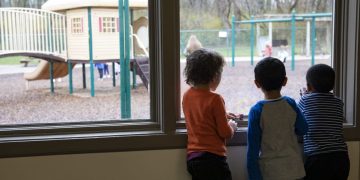Education experts say they’re ready for AI this time

Artificial intelligence (AI) is blazing a new trail this year in education as schools take concrete steps to incorporate the technology into their teaching, replacing the panic and confusion educators previously faced.
Arizona State University (ASU) is leading the charge in higher education, announcing a partnership with OpenAI, the creator of ChatGPT, on a “pilot” program to make AI a core part of professors’ and students’ lives.
“Our goal in this really is to recognize that generative AI is a technology that has a role currently, but also will continue to be a part of the job prospects that our students have,” said Kyle Bowen, deputy chief information officer for ASU Enterprise Technology. “It’ll continue to change and and modify the environments that we work and learn in, and so it’s critical for us to be kind of active participants to help define what the future of that technology looks like.”
Anne Jones, vice provost for undergraduate education at ASU, said now is the time for schools to find out where AI can help them, as well as where it isn’t working.
“I think you have to think of the next year as being a kind of a pilot phase or a preliminary phase of thinking about how to effectively use these technologies in the context of a public research intensive university,” Jones said.
Some K-12 administrators have also partnered with AI education groups to help teachers learn more about the technology and how they can wield it.
And lawmakers at the end of 2023 introduced the “Artificial Intelligence Literacy Act,” which would allow schools to use federal funds for AI literacy efforts.
Last year, when AI first hit education in force, schools and teachers struggled to keep up. Multiple K-12 districts initially banned the technology, and some college professors grappled with how to prevent cheating, including changing how they conduct homework and testing.
The game is shifting as educators and lawmakers get their footing and a better understanding of how AI can advance student learning.
In a recent report from Imagine Learning, one-third of K-12 administrators believe AI can help teachers with personalized learning materials and save them time; 64 percent of administrators say generative AI will have a positive impact on education.
While optimism is there, experts such as Lily Bi, president and CEO of Association to Advance Collegiate Schools of Business (AACSB), have stressed that schools will have to prepare teachers with guidance and training to make a smooth transition.
“Last spring, AACSB released a survey focused on digital transformation and learned that although overall faculty are receptive to the opportunities of Gen AI, there is still a significant proportion who have many concerns ranging from, adverse impacts to learning, to potential job displacement,” Bi said.
“Business schools need to ensure that faculty have the necessary support to leverage this technology in their teaching, whether that means professional development opportunities, IT support, or the space to learn and experiment with the technology.”
Multiple states have now put out guidance for schools on how to bring AI into the classroom.
North Carolina released its best practices earlier this month, including a chart that can be used to describe what level of AI is allowed on an assignment for a student.
“These generative AI implementation recommendations and considerations have been created as a way to share information and resources to help direct responsible implementation of generative AI tools and guide AI Literacy in North Carolina Public Schools,” the North Carolina guidance reads.
While some more comfortability with AI has increased in the past year, concerns still linger as educators press forward with the technology.
“There are also challenges and harms to consider, because we’re talking about automating decisions at scale, and we want to ensure that we’re not reproducing existing harms. And as we know, the training data that these that these tools are built on are biased, because the data is coming from humans,” said Pati Ruiz, senior director of Edtech and Emerging Technologies for Digital Promise.
regular post copyright









